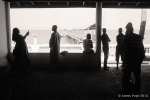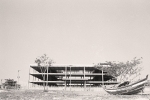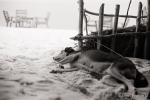Tales of pygmy hippos and wild chimpanzees had lured me off Sierra Leone’s beaches to an island deep in the country’s eastern rainforest.
Four miles long and a mile wide, Tiwai splits the River Moa, forming a moated sanctuary for some of the planet’s rarest species. You can reach the Moa by 4×4, but I took the cheap option – a butt-clenching motorbike taxi ride along rust-red and increasingly unmade roads to a Mende village on the west bank. From there, a local tribesman ferried me to Tiwai by canoe.
The island is uninhabited. Its only buildings are a research station for scientists, and a small tourist camp – both staffed by locals from neighbouring villages. Local rumour goes that the rainforest sounds in Avatar were recorded on Tiwai. At night, as I lay sweating in a tent with crickets, cicadas, frogs and god knows what else going fortissimo all round me, I was prepared to believe it.
Days were spent lazing in a water’s-edge hammock watching the river’s oily eddies, or on guided excursions into the jungle. It was the end of dry season and everything crunched. We stepped over meandering buttress roots and streams of termites, their millions of tiny feet rain-like on the leaf litter. Hornbills wheezed overhead. Vultures and eagles nested messily in the high trees.
Our guide grabbed us to point out various species of monkey tumbling through the canopy and bolting across our path. During the civil war, rebels stationed on the island ate many of its primates, including the endangered chimpanzees and red colobus monkeys. But with the island protected again, numbers there are bouncing back and Tiwai now has one of the highest concentrations and greatest diversities of primates in the world.
Despite this, and despite getting up wearily early for the purpose, we didn’t see a single chimpanzee. Though we did discover where they use rocks to break open palm nuts – behaviour only seen in West African chimps.
Even more disappointing: not a whiff of pygmy hippo. It’s estimated only three thousand remain in the whole of West Africa. They’re also nocturnal and incredibly shy and I was only on Tiwai three nights, so maybe I’d have been lucky… and it’s a great excuse to go back.
Photos: Rolleiflex SL35, Rollei Planar 50mm f1.8, Schneider Kreuznach 35mm f2.8, Kodak Tri X 400 developed in Kodak XTOL, 9 mins at 20 degrees


































